When you live in western America, earthquakes are always in the back of your mind. For most of us, it certainly is not a crippling fear. There isn’t an annual season to worry about it (unlike those poor souls in tornado alley or along the hurricane-plagued Gulf coast).
Yet, earthquakes make freeway overpasses scary. That persistent nagging each time you’re underneath and see the crushing mass of concrete suspended overhead. The right jolt from Mother Nature could bury you in dusty heap of broken dreams.
Perhaps my recent video on the Loma Prieta Earthquake in 1989 (which ended 42 lives in the Cypress Freeway Disaster) leaves me overly sensitive.
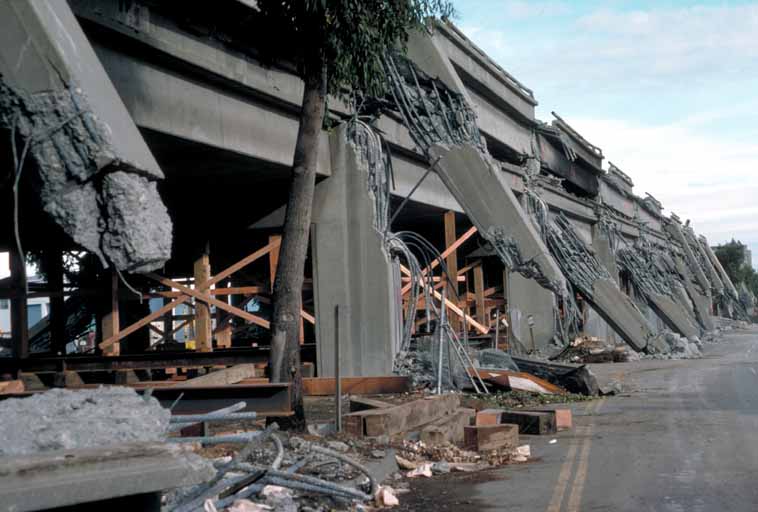
Have bridges been properly retrofitted?
No major earthquake has spared all of California’s bridges. In the 1971 San Fernando earthquake, the Newhall Pass near Santa Clarita got messed up. The 605 freeway lost a bridge deck during the 1986 quake. The Bay Area dealt with the deadliest freeway disaster in American history after Loma Prieta in ’89. And the same Newhall Pass interchange collapsed again in the 1994 Northridge earthquake.
Each time a major earthquake happens (“seismic event,” in engineer-speak), the state sends a team of engineers to act as forensic experts to figure out why a structure failed, what could have prevented it from failing, and what other bridges suffer from the same risk.
After the flurry of quakes in the 1980s and 90s, the state identified 2,203 bridges in need of retrofitting. Voters approved a ballot measure in 1996 which authorized the state to bond $2,650,000,000 to make retrofits to bridges at risk of serious failure during a seismic event.
Signs of these retrofits are everywhere, hiding in plain sight. It may be a weird color on a bridge column, out of place cable, or superfluous set of supports. To the untrained eye of we the motoring public, it looks like — something weird.
The Catcher Bent
What the heck is this thing? Well, you tell me.
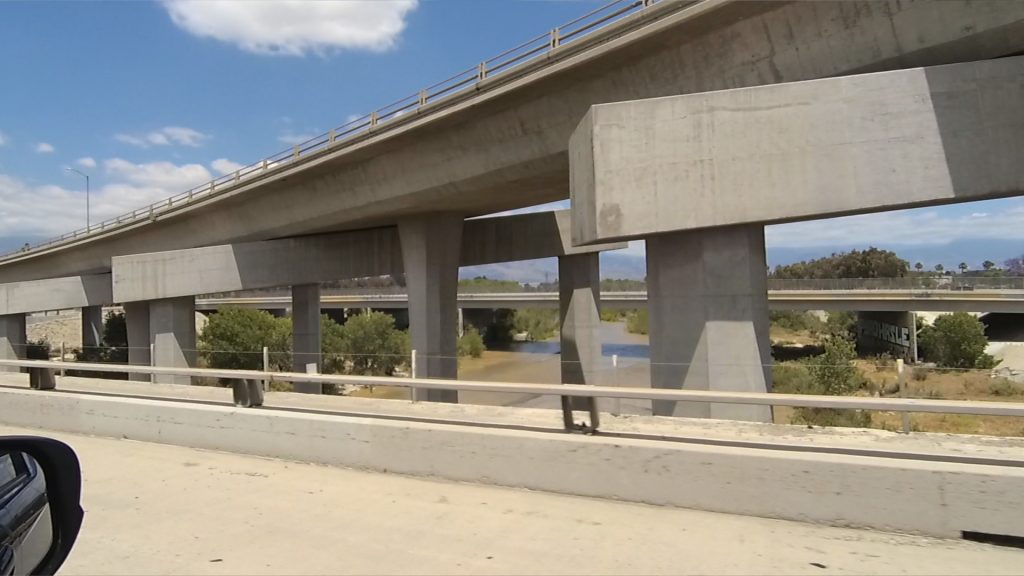
I first noticed these super ugly “bonus” bridge supports underneath a 1960s-era flyover bridge in San Bernardino. What’s weirder is these massive columns (called “bents”) don’t actually touch the bridge. If you look carefully, there’s an air gap.
My curiosity got the best of me. I reached out to Caltrans for this story, and their staff got me in touch with an expert.
I met Jerry De Santos in the lobby of the California Department of Transportation’s regional office in downtown San Bernardino. He is the supervising bridge engineer for San Bernardino, Riverside, Inyo, and Mono Counties. He downplays his prominence, but he’s also an acting district supervisor (there are only 12 statewide).
One would describe Jerry as an “outgoing engineer.” He wears the uniform of an engineer (button up shirt, no tie, but no pocket protector). He’s certainly not camera shy. His hands gesticulate with his engineering descriptions. Enthusiasm for his team’s work spreads a friendly smile across his face.
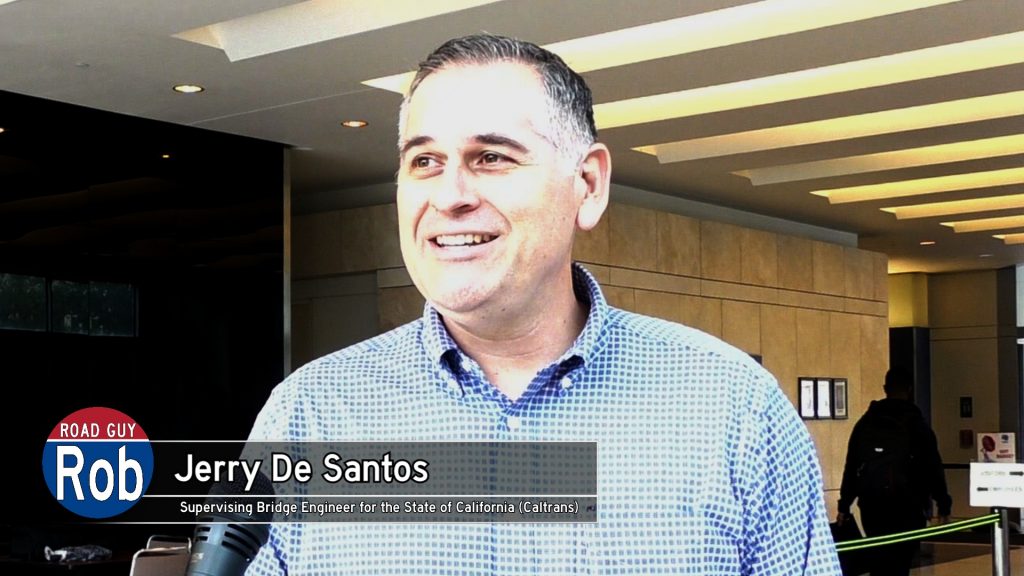
I showed him a photograph of the mystery supports on the 10/215 interchange. As one would expect, he immediately knew what it was.
“That is a catcher bent,” De Santos explained. “That was a solution designed for that structure. And there’s many different kinds of solutions. You see, an earthquake is a horizontal force, right? So we put elements to basically make the structure not fall off.”
Twice a year, the Federal Highway Administration (FHWA) requires states to conduct an inventory their bridges and identify ones with structural and seismic deficiencies. The 10/215 interchange must have demonstrated susceptibility to falling down during a major earthquake. So, engineers designed these extra supports (called “bents”) to catch the bridge as it falls. This means the failing bridge would drop mere inches instead of plummeting to the ground. Hence the term, catcher bent.
So far, this is the only example of a catcher bent I’ve seen. If you spot another one, shoot me an email. I’d love to check it out.
Column Harmonics
An engineer’s mind must race after a major earthquake collapses part of a freeway interchange. Perhaps a combination of shock, urgency, and a small bit of humiliation. How much worse it must have felt for senior engineering staff to witness the Newhall Pass interchange collapse a second time, after only 23 years?
Engineers learn from experience. Error offers the profession deep experience.
“We have a certain design criteria and every time there’s a big event we have engineers that will go and assess the situation,” De Santos told me. “We go back and we research and we change our design practice.”
After the 1994 quake, engineers discovered how the tall vertical columns which support flyover ramps behave during ground shaking. It’s almost as if Mother Nature strums the columns like guitar strings. And like the musical instrument, the “note” (harmonic pitch) of the column’s vibration changes depending on its length. A shorter column makes a short wavelength, while longer columns have longer wave lengths.
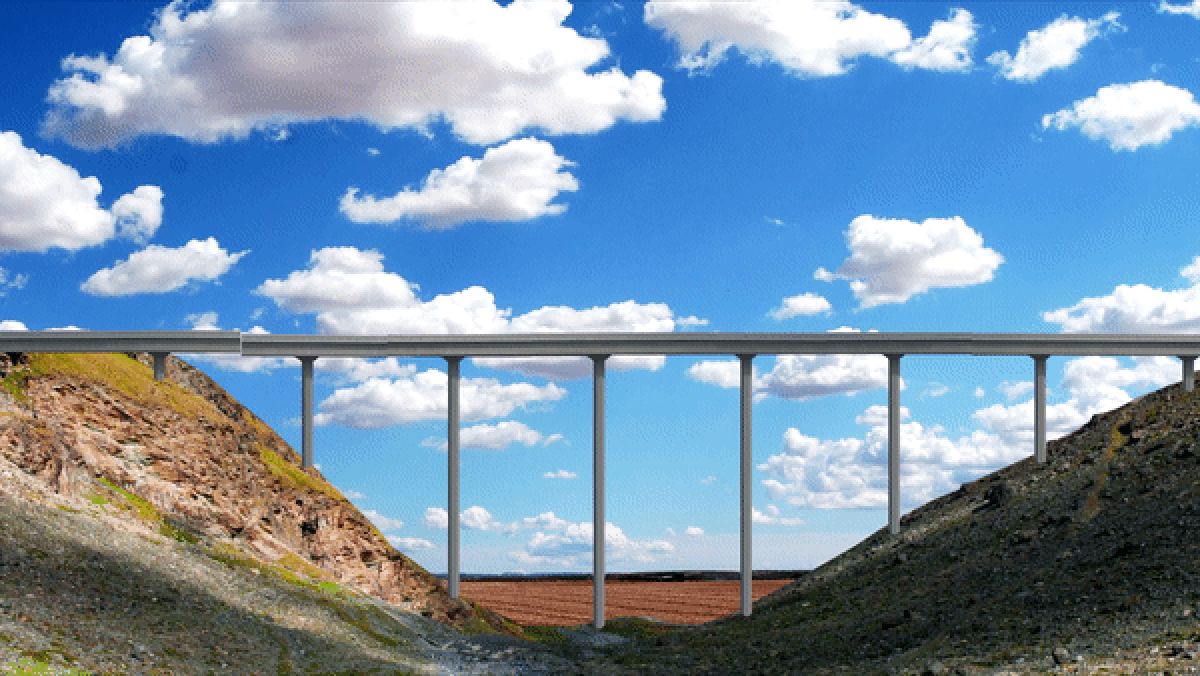
“You have the lollipop effect where the higher the bridge is, the larger the frequency.”
The bridge feels pain. It’s not unlike what your head feels as a two-year-old child hammers discordant notes on a piano. Each vertical column vibrates at its own unique frequency. The bridge superstructure (the top part you actually drive on) starts shredding apart in the middle where the two frequencies meet.
So, engineers starting building new flyover connector bridges using a simple trick. What if each of the bridge columns could be the same height? This way when an earthquake shakes the bridge, the entire structure would move as a single unit, shaking at the same frequency.
However, it’s easy to say, “let’s make all the columns equal height.” Doing so is a different matter entirely. The ground changes height. The bridge changes height. Flexibility in column height is, well, really important.
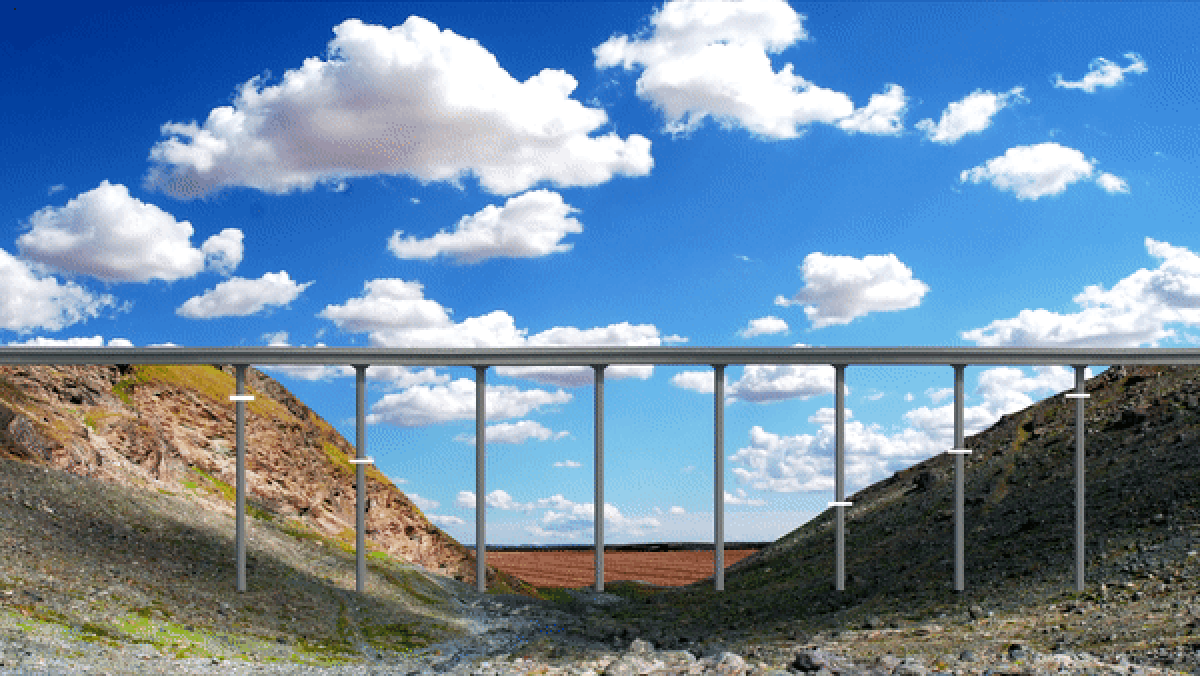
If designers cannot change the bridge’s height or the elevation of the existing ground, they can artificially change where the column connects with the ground. Where a column is short, construction crews will dig a pipe deep into the ground. The column then sits inside the pipe, and attaches dozens of feet below the ground.
The effect works brilliantly. The column looks like it is shorter, but the pipe conceals its actual height. You can see these pipes in action along the newer carpool connector ramps at the Interstate 15 and California 91 interchange in Corona, and along Interstate 215 in downtown San Bernardino.
Bridges Which Crash Like Cars
New bridges, like those which take into account harmonics, are fundamentally better prepared for a large earthquake than the old bridges are. Ideally, when California identifies a bridge that’s not up to snuff, they’d knock it down and build a brand new one. But that’s not cost effective.
“We’re not going to redesign a bridge if it doesn’t need it. So we’re gonna go back to the retrofitting, which is an economical way to make it safe.”
Instead, engineers find innovated and cost-effective ways to build figurative (or literal) safety nets to minimize the cost of human life.
“Safety is our priority,” De Santos said. “We have a retrofit program where we are looking at our inventory, looking at our designs, looking at what needs to be updated. So there’s a lot of behind the scenes work that’s going on.”
“We don’t want the bridge to have full failure, there are cracks, things may spall, that’s failure. But obviously not catastrophic.”
Column Reinforcement
Here’s another noodle scratcher. Throughout California there are huge freeway interchanges with flyover bridges. These are held aloft in the air by elegant concrete columns, many constructed during the 1960s and 1970s.
Over the past few years, most of these columns have developed a beer belly. There is a jacket formed around the column which makes it look kind of fat. I couldn’t help but wonder if this was another seismic retrofit hiding in plain sight.
“I’m really proud of my wife,” De Santos said. “When we travel out of state, and she’ll see different bridge columns, she’ll say, ‘Oh that’s a very slender column.’ It’s not a Caltrans earthquake column.”
He told me the columns contain steel rods inside concrete. The rods require the concrete containment, otherwise the mass of the bridge and its traffic would bend the metal rods outward which would cause the bridge to fall down.
Earthquakes have a nasty habit of cracking up concrete, be it on the ground, in a building, or part of a vertical column. When the concrete cracks, the metal no longer is contained. It protrudes outward and causes collapse.
“Before we spaced our hoops 1 foot apart,” he told me. “There wasn’t much horizontal confinement of the concrete. So if it did crack, it would just crack and fall out. So what we are trying to do is keep that core of concrete so and even though its cracked it going to be strong enough for that axial load to keep the bridge up. So we’re creating this kind of jacket that’s going to keep the concrete so even if it cracks from falling down.”
These “beer bellies” are actually full metal jackets which Jerry tells me are wrapped around the column and welded on. The jacket and the column are rarely a perfect fit.
“We’d love it to be perfect. Fit like a glove. So the inside is filled with grout. And again, that’s to create that confinement. And then we now have that column that’s confined fully for an event.”
The older bridge can now bust up terribly, yet stay functional enough to help motorists escape the structure without injury. Promptly re-opening to traffic after the earthquake is an entirely different story. Old bridges crash like old cars — the safety equipment help everyone survive, but it’s thrashed and unusable afterward.
Cable Ties
Many of the seismic retrofit techniques Caltrans uses are less applicable to the types of bridges other states build. Utah, Colorado, and other wintry states typically build steel girder bridges which are easier to inspect for water damage. These are quite different from the box girder bridges built out west.
“In California, our bread and butter is the concrete cast-in-place structure,” De Santos told me. “It’s economical for us, we have the material — water, sand, rock, cementitious materials as a very economical price. Steel is great, but kind of on the expensive side.”
Although far less common, there are steel girder bridges in California. I noticed one in the high desert town of Barstow. The older 1960s-era bridge had wires attaching the steel columns to the concrete vertical columns. I asked if this too was an earthquake retrofit.
“Yes, we have these steel girders which are sitting on top of a bent cap. We attach cables together to the steel girders, so if there’s enough horizontal force they keep each other from falling off that bent cap.”
Hinge Restrainers
I once say a magnificent Catholic cathedral in downtown Los Angeles. My passenger, a snarky local, jokingly told me it was named “Our Lady of the Freeways.” Until this very moment, I hadn’t realized he’d lied to me.
Such a name would make sense. California has some magnificent freeway interchanges with impressively long bridge spans. These connector ramps can often be over one-quarter of a mile long.
“Sometimes on a very long bridge connector, you’ll see something like a step,” De Santos said. “We’re trying to create a point of no moment, which is a bending force. So we put this hinge in there to prevent the moment transfer.”
In engineer-speak, a “point of no moment” is a feature which takes unpredictable bending forces a bridge experiences and encourages them to happen in a specific place. I like to think of it as a fold in a long sheet of paper. You know 100% the bending force on the paper will happen at the fold and not some place else. That sort of predictability is exactly what an engineer seeks.
On a bridge, these hinges look like two steps sitting on top of one another. Some older bridge spans have hinges which are very short. In an earthquake, bridges have been known to vibrate apart at these hinges.
“So at the hinges we put hinge restrainers,” De Santos told me. “It’s a cable that’s inside. So if there’s enough displacement, that cable will prevent that hinge from unseating.”
He did warn me that these hinges do expand and contract with the weather. On hot days, bridges begin to look like they are coming apart. Concerned motorists will call Caltrans to warn them. Engineers smile and calmly explain how hinge restrainers prevent collapse from happening.
Abutment Seat
Seismic engineering is by far the most complicated form of civil engineering. Among engineers who have taken the exam for a professional license, there’s a bit of street cred for the Californians. Instead of a two-day exam, all California engineers sit for a third day which is exclusively earthquake engineering. Most don’t pass on their first try.
Given this context, it is highly amusing how simple seismic retrofits can be. For instance, the abutment seat.
There’s little to explain here. If an earthquake were to cause the bridge to scoot sideways to a point where it would fall from its anchor, a block of concrete catches it.
Simple, yet live-savingly effective.
Are Bridges Safe?
After the 1989 and 1994 earthquakes shook California’s two largest metropolitan areas, the state quickly worked to identify all bridges which posed a hazard to the public. The identified 2,203 bridges which needed immediate attention.
Fixing bridges takes serious money. The state estimated around $2.65 billion dollars were needed right away. Mere months after the Northridge Earthquake, a measure appeared on ballots across California. In a bout of befuddlement, voters REJECTED the measure. Soundly.
Undeterred, state lawmakers voted again in 1996 to put the measure on the ballot a second time. Mercifully, it passed. Since ’96, engineers got to work fixing 2,202 of the 2,203 bridges and have done so under budget. The last remaining bridge is the Oakland Bay Bridge replacement project, which should wrap up soon.
In my personal opinion, I feel confident that the state-owned bridges in California are best prepared for a major earthquake than they have been since the freeway system was originally constructed.
Other “Ring of Fire” states are not quite as lucky. The state of Washington has been chipping away at its backlog of unsafe bridges, but funding from Olympia has been spotty and subject to regular budget cuts. Less than one-third of the backlog has been tackled.
Oregon is in even worse shape. The state has not appeared to identify any funding at all. Squeezing a few drops out of their already very stretched budgets, engineers have managed to retrofit around 150 bridges. Many along US-101 are identified to “likely collapse” in a major earthquake. The state may be fortunate enough to avoid large human casualties. But it won’t be spared from a post-quake traffic nightmare.
It seems clear to me that past failures have given structural engineers a vast knowledge of how to prevent future tragedy. It’s exciting to see states implement changes which will save countless lives in inevitable future earthquakes. Even cost-effective retrofits still cost money. Hopefully constituents and lawmakers in other states will be persuaded to identify funding mechanisms before the next big earthquake.
If not, they’ll certainly be looking for money afterward.
